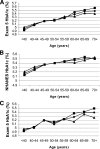Effect of aging on A1C levels in individuals without diabetes: evidence from the Framingham Offspring Study and the National Health and Nutrition Examination Survey 2001-2004
- PMID: 18628569
- PMCID: PMC2551641
- DOI: 10.2337/dc08-0577
Effect of aging on A1C levels in individuals without diabetes: evidence from the Framingham Offspring Study and the National Health and Nutrition Examination Survey 2001-2004
Abstract
Objective: Although glycemic levels are known to rise with normal aging, the nondiabetic A1C range is not age specific. We examined whether A1C was associated with age in nondiabetic subjects and in subjects with normal glucose tolerance (NGT) in two population-based cohorts.
Research design and methods: We performed cross-sectional analyses of A1C across age categories in 2,473 nondiabetic participants of the Framingham Offspring Study (FOS) and in 3,270 nondiabetic participants from the National Health and Nutrition Examination Survey (NHANES) 2001-2004. In FOS, we examined A1C by age in a subset with NGT, i.e., after excluding those with impaired fasting glucose (IFG) and/or impaired glucose tolerance (IGT). Multivariate analyses were performed, adjusting for sex, BMI, fasting glucose, and 2-h postload glucose values.
Results: In the FOS and NHANES cohorts, A1C levels were positively associated with age in nondiabetic subjects. Linear regression revealed 0.014- and 0.010-unit increases in A1C per year in the nondiabetic FOS and NHANES populations, respectively. The 97.5th percentiles for A1C were 6.0% and 5.6% for nondiabetic individuals aged <40 years in FOS and NHANES, respectively, compared with 6.6% and 6.2% for individuals aged >or=70 years (P(trend) < 0.001). The association of A1C with age was similar when restricted to the subset of FOS subjects with NGT and after adjustments for sex, BMI, fasting glucose, and 2-h postload glucose values.
Conclusions: A1C levels are positively associated with age in nondiabetic populations even after exclusion of subjects with IFG and/or IGT. Further studies are needed to determine whether age-specific diagnostic and treatment criteria would be appropriate.
Figures

References
-
- Davidson MB: The effect of aging on carbohydrate metabolism: a review of the English literature and a practical approach to the diagnosis of diabetes mellitus in the elderly. Metabolism 28:688–705, 1979 - PubMed
-
- Selvin E, Coresh J, Brancati F: The burden and treatment of diabetes in elderly individuals in the U.S. Diabetes Care 29:2415–2419, 2006 - PubMed
-
- Nathan DM, Singer DE, Hurxthal K, Goodson JD: The clinical information value of the glycosylated hemoglobin assay. N Engl J Med 310:341–346, 1984 - PubMed
-
- Nathan DM, Buse JB, Davidson MB, Heine RJ, Holman RR, Sherwin R, Zinman B: Management of hyperglycaemia in type 2 diabetes: a consensus algorithm for the initiation and adjustment of therapy. Diabetologia 49:1711–1721, 2006 - PubMed
-
- Arnetz BB, Kallner A, Theorell T: The influence of aging on haemoglobin A1c (HbA1c). J Gerontol 37:648–650, 1982 - PubMed
Publication types
MeSH terms
Substances
Grants and funding
LinkOut - more resources
Full Text Sources
Medical

